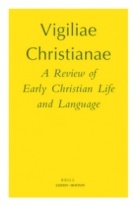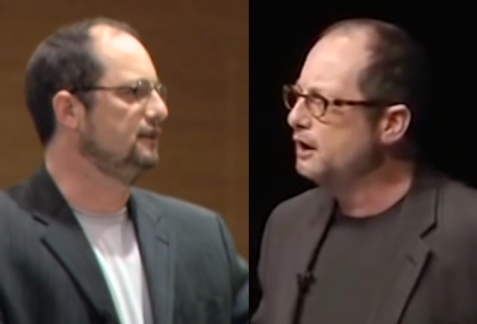Another Guest Post by David Blocker
Allusions to Christianity and Post Neronian texts in the Satyricon’s Cena Trimalchionis, The Satyricon and Allegations of Christian Cannibalism
A Proposal that Titus Petronius Secundus, not Titus Petronius Arbiter, was the author of the Satyricon.
The attached table can be found here:
The Satyricon’s “Cena Trimalchionis”: Literary Allusions to the Gospels and Other Contemporaneous Texts.
Literary parallels between the Satyricon’s Tale of the Ephesian Matron and the New Testament were previously demonstrated[1].
Another chapter in the Satyricon, the Cena Trimalchionis[2], contains numerous allusions to the Old Testament, the canonical gospels, particularly the gospel attributed to John, letters attributed to Paul and James, the works of Flavius Josephus, material found in apocryphal Christian texts, and subjects appearing in the Natural History of Pliny the Elder, in letters of Pliny the Younger, in Martial’s Epigrams and in the histories of Suetonius and Tacitus.
The Cena Trimalchionis narrates the events that occurred during a banquet hosted by Trimalchio, a nouveaux-riche freedman.
The accompanying table compares extracts from the Cena Trimalchionis to passages from other texts.
Each column of the table contains an extended excerpt from the texts under consideration. The texts are arranged so that analogous passages will be side by side in parallel rows.
The first or left hand column of each row lists shared topics in the passages within the other cells of the row. Parallel phrases in each row are either highlighted or emphasized with a distinctive font.
The cells in the second column contain the text of the Satyricon’s Cena Trimalchionis, the cells of the third column contain parallels extracted from the New Testament, and the cells in the fourth or right hand column contain texts extracted from other documents.
Where necessary, endnotes provide the complete passage, its context, source, and additional comments.
A cursory inspection of the Table suggests that the Cena Trimalchionis’ most significant New Testament allusions are to the Gospel of John. This also seems to be the case for the New Testament allusions found in the Tale of the Ephesian Matron[3].
The relationship of the Satyricon to the Gospel of John requires further investigation since the current scholarly consensus assumes that the Satyricon was written prior to the Gospel of John.
The author of the Satyricon also alludes to narratives that have their only surviving parallels in the Toledoth Jesu[4]. This suggests that the antiquity of the Toledoth Jesu and/or its sources is much greater than commonly acknowledged.
The last three rows of the Table are from a fragmentary, incompletely preserved, portion of the Satyricon. In this section of the text, Eumolpus left a will requiring that his beneficiaries eat his corpse if they wish to inherit his estate[5].
This fragment of the text contains a reference to Josephus’ War of the Jews and a possible allusion to the Gospel of John. This incomplete portion of the Satyricon might have been part of an episode parodying the symbolic cannibalism of the Christian Eucharist.
As evidenced by the references to gossip, events and people that also appears in the writings of the two Plinys, Martial, Suetonius and Tacitus, the author of the Satyricon seems to have been a Roman addressing other members of an elite circle of upper class Romans.
The Satyricon makes oblique references to Christianity’s rites and literature. Allusions to Christianity in the Satyricon’s Tale of the Ephesian Matron1 were used to mock and parody Christian beliefs and rituals. The use of allusions to Christianity in the Satyricon’s Cena Trimalchionis, however, seems like a virtuoso display where the author is showing off his store of information about Christianity. The author of the Satyricon cites not only the texts adopted by orthodox Christianity, but texts written by rivals, critics and detractors of what would become orthodox Christianity. The allusions to Christianity in the Cena Trimalchionis are presented as a series of individual display pieces rather than as connected elements of a narrative. Only when the story turns to Eumolpus’ will, do the allusions to symbolic Christian and alleged Judean cannibalism contribute to a greater narrative framework about bilking legacy hunters.
I leave further analysis and interpretation of the Table to the reader. Hopefully, the Table will inspire further scholarship leading to the discovery of additional relationships between the Satyricon and contemporary texts and to the elucidation of the significance of these relationships.
The Satyricon alludes to events and passages in texts that were written after the reign of Nero[6].
The authorship of the Satyricon is usually assigned to Titus Petronius Arbiter[7], one of Emperor Nero’s courtiers. The Satyricon’s post 66 CE allusions make it impossible for Titus Petronius Arbiter to have been its author. Petronius Arbiter committed suicide circa 66 CE, before many of the texts referred to by the Satyricon were written.
Assuming that the manuscript attributions of authorship to “Titus Petronius” are correct, a better candidate for authorship of the Satyricon is Titus Petronius Secundus[8] (40–97 CE).
Titus Petronius Secundus was governor of the province of Egypt from c. 92 to c. 93 CE. This posting would have exposed him to the Jewish community of Alexandria, refugees from the first Jewish Revolt, and members of the Christian sect. From 94 to 96 CE, he was a prefect of Emperor Domitian’s Praetorian Guard. As a member of the Imperial household, Petronius Secundus would have had the opportunity to read Martial’s verses and meet Josephus, Suetonius, Tacitus and Pliny the Younger, and be familiar with events, people and places they wrote about.
Titus Petronius Secundus left epigraphic evidence that he was bilingual in Latin and Greek, as was the author of the Satyricon[9], and had pretentions of being a poet. Samples of poetry are scattered throughout the Satyricon.
When Titus Petronius Secundus was governor of Egypt, he visited the statue of Memnon and had a Latin statement commemorating his visit and a Greek verse that he had composed, inscribed on the statue’s leg[10].
I propose based on the foregoing statements, that first the Satyricon was written after the reign of Nero, and second, that Titus Petronius Secundus is a better (though not the only) candidate than Titus Petronius Arbiter for the authorship of the Satyricon[11].
The Satyricon also refers to anti-Christian allegations recorded in the Sefer Toledoth Jesu[12], in Celsus’ The True Word (Ἀληθὴς λόγος/Alēthēs logos) and in the refutations written by Christian apologists of the 2nd through 4th centuries. Since these texts were composed after the death of Petronius Secundus, the allegations must already have been in circulation during his lifetime—if he is the author of the Satyricon.
The Satyricon alludes to events, persons and places mentioned in Gaius Suetonius Tranquillus’ The Twelve Caesars[13] which was written during the reign of Hadrian, and to works of Tacitus and Pliny the Younger which were all distributed after the death of Titus Petronius Secundus. The texts were published after the death of Petronius Secundus, but referred to events that occurred during the lifetime of Petronius Secundus. Petronius Secundus and Suetonius had overlapping life times, and they both lived in Rome where they would have been privy to the same anecdotes and the same libraries.
The Satyricon, therefore, could not have been written by Titus Petronius Arbiter, since it contains references to material written after his death. Titus Petronius Secundus is a better candidate to be the Petronius who allegedly authored the Satyricon.
An alternate hypothesis about the authorship of the Satyricon was proposed by Stephan Ratti. He proposed that it was written during the second decade of the 2nd century CE by a freedman in Pliny the Younger’s household who adopted the pseudonym “Petronius”11.
I place more credence on the manuscript attributions of authorship to Titus Petronius, while Stephan Ratti bases his hypothesis on the high frequency of topics that are shared by the Satyricon and Pliny’s letters.
If the Satyricon was indeed written during the last decade of the first century CE by Titus Petronius Secundus, the parody of Christian traditions found in the Tale of the Ephesian Matron, and the allusions to Christianity found in the Cena Trimalchionis and in the fragmentary cannibal passages of the Satyricon are the earliest surviving non-Christian literary references to Christianity that are not tainted with the suspicion of being Christian forgery[14]. Allusions to the Gospel attributed to John in a text dated to the last decade of the 1st century CE, would require rethinking not only the dating of the Gospel attributed to John, but the Synoptic problem as well.
David Blocker, 2016.12.28.
——————————————————
[1] https://rogerviklund.wordpress.com/2016/04/24/the-relationship-between-the-satyricons-tale-of-the-ephesian-widow-and-texts-associated-with-early-christianity/ or https://web.archive.org/web/*/https://rogerviklund.wordpress.com/2016/04/24/the-relationship-between-the-satyricons-tale-of-the-ephesian-widow-and-texts-associated-with-early-christianity/).
See also endnote 3
[2] The Cena Trimalchionis is an incident in the Satyricon, a long Latin novel of which only fragments survive. In this episode the narrator, Encolpius, and his companions are invited to a dinner given by Trimalchio, a nouveux riche freedman.
[3] https://rogerviklund.files.wordpress.com/2016/04/table-ephesian-widow-and-the-gospels-2016-04-21.pdf
or
[4] Incidents found in both the Toledoth Jesu and the Satyricon include playing “catch the ball by a pool of water”, “barking entryway guardians”, “an event seen by two witnesses”, and “a betrayal preceded by an act of sodomy”.
Most mainstream scholars date the Toledoth Jesu to the 6th century or later, though a few have placed it as early as the 2nd or 3rd century. https://en.wikipedia.org/wiki/Toledot_Yeshu#Composition_and_dating, recovered 2016/11/30.
[5] “All those who come into money under my will, except my own children, will get what I have left them on one condition, that they cut my body in pieces and eat it up in sight of the crowd.” Satyricon 141.
[6] Nero, died: June 9, 68 AD.
Please see the accompanying Table for specific examples of texts written after 66 CE.
These include references to the New Testament, and passages from the works of Martial, Josephus, Suetonius, Tacitus, and the two Plinys (the Elder and Younger).
[7] https://en.wikipedia.org/wiki/Petronius (recovered 10/10/2016).
[8] https://en.wikipedia.org/wiki/Titus_Petronius_Secundus
[9] See J. R. Morgan, “Petronius and Greek Literature”, in Prag, Jonathan and Ian Repath (eds). Petronius: A Handbook (Blackwell Publishing, 2009, Chapter 2).
[10] Titus Petronius Secundus’ inscription on the statue of Memnon has survived until modern times. In antiquity the statue was famous for making a sound when warmed by the rising sun.
A French translation of the Greek and Latin inscription is given below:
« Quand l’empereur Domitien César Auguste Germanicus exerçait son seizième consulat, Titus Petronius Secundus, préfet d’Egypte, entendit Memnon, à la première heure, la veille des ides de mars, et l’honora des vers grecs écrits ci-dessous : « Tu as émis un son, Memnon, car une partie de toi-même est assise en ce lieu, quand le fils de Latone te frappait de ses rayons brûlants. » Par les soins de Titus Attius Musa, préfet de la deuxième cohorte des Thébains.*» (Date : le 14 mars 92 p.C.)
Source : ”Les inscriptions grecques et latines du colosse de Memnon” par André et Etienne Bernard – I.F.A.O. – 1960.
* “When the Emperor Domitian Caesar Augustus Germanicus exercised his sixteenth consulship, Titus Petronius Secundus, prefect of Egypt, heard Memnon, at the first hour, on the eve of the ides of March, and honored him with the Greek verses written below: ‘You made a sound, Memnon, because a part of you is sitting here, when Latona’s son struck you with his burning rays.’ “Under the supervision of Titus Attius Musa, prefect of the second cohort of Thebans.” (Latona/Leto: A Greek goddess, the mother, by Zeus, of Apollo (the god of the sun) and Artemis.)
[11] Stephane Ratti proposed that the Satyricon was written late in the reign of Trajan, after 107–111 CE, by a freedman of Pliny the Younger, most likely Pliny’s reader Encolpius. Ratti suggests that Encolpius used “Titus Petronius” as his pseudonym.
Stéphane Ratti, “Relire le Satyricon. Pline le Jeune et les chrétiens, cibles du roman secret d’un affranchi cultivé”, Anabases, v. 22, 2015, p. 99–145.
Stéphane Ratti and I agree that Petronius Arbiter was not the author of the Satyricon. I propose that the Satyricon was written by Titus Petronius Secundus (c. 40–97) during the reign of Domitian. Titus Petronius Secundus would have to have known Pliny the Younger and have completed the Satyricon before he (Petronius Secundus) was murdered in 97 CE.
M. Ratti places the Satyricon at a later date, during the reign of Trajan, and proposes that its author was Encolpius, Pliny the Younger’s reader (literary secretary). Encolpius appears to have died while in Pliny’s service (Letters 8.1 and 8.19, Letters of Pliny the Younger) at an unknown, indeterminate date.
[12] The dating of the Sefer Toldoth Jesu, a deprecatory biography of Jesus, is a contentious subject. While there is no scholarly consensus, no established scholar has dated it earlier than the second century. See https://en.wikipedia.org/wiki/Toledot_Yeshu (recovered 10/10/2016) for a group sourced discussion of the composition and dating of the Toldoth Jesu.
[13] Gaius Suetonius Tranquillus (c. 69–after 122 CE)
https://en.wikipedia.org/wiki/The_Twelve_Caesars (recovered 10/10/2016)
[14] Josephus’ Antiquities of the Jews, which contains the Testimonium Flavianum (Antiquities of the Jews 18.3.3, was written circa 93/94 CE (https://en.wikipedia.org/wiki/Antiquities_of_the_Jews). The Testimonium Flavianum is a laudatory statement about Jesus.
There is controversy about whether or not the Testimonium Flavianum is a forgery (See Feldman, Louis H., Josephus and Modern Scholarship, Berlin; New York: W. de Gruyter, 1984, for arguments concerning the authenticity of the Testimonium Flavianum).
Pliny the Younger’s correspondence with Trajan (Pliny, Letters 10.96–97) (c. 112 CE) concerns whether or not Christians should be treated as criminals. Pliny the Younger’s letter imply that he had heard rumors of misdeeds occurring at Christian feasts. According to my (Blocker’s) hypothesis Pliny’s letters to Trajan were written over a decade after the Satyricon had been written.
According to S. Ratti’s hypothesis (See endnote 11 ) the Satyricon and Pliny’s correspondence with Trajan were approximately concurrent.
A recent essay has questioned the authenticity of Pliny’s Letter to Trajan (Enrico Tuccinardi, “An Application of a Profile-Based Method for Authorship Verification: Investigating the Authenticity of Pliny the Younger’s Letter to Trajan Concerning the Christians,” Digital Scholarship in the Humanities, published online: 14 February 2016. http://dsh.oxfordjournals.org/content/early/2016/02/12/llc.fqw001).




